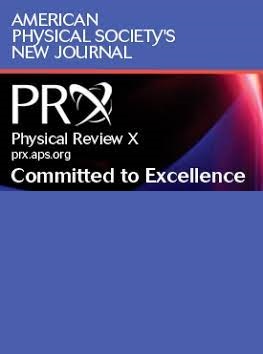探索四端Josephson结的能谱:朝向拓扑Andreev带结构
IF 15.7
1区 物理与天体物理
Q1 PHYSICS, MULTIDISCIPLINARY
引用次数: 0
摘要
混合多端Josephson结(JJs)有望包含一类新的Andreev束缚态(ABSs),包括四端器件中的拓扑非平凡态。在这些系统中,当abs依赖于至少三个超导相位差时,拓扑相就会出现,从而产生以零能量的Weyl节点为特征的三维能谱。在这里,我们实现了Al/InAs杂化异质结构中的四端JJ,其中abs形成了合成的三维带结构。我们使用隧道光谱探测能谱,并确定与三安德列夫分子形成相关的光谱特征,三安德列夫分子是一种束缚态,其能量取决于三个超导相,因此能够承载拓扑abs。数值模型很好地描述了实验结果。计算预测在小于实验分辨率的间隙内出现四个零能量的Weyl节点。理论上预测这些拓扑状态在参数空间的扩展区域内保持稳定,我们的设备可以很好地访问。这些发现为研究多端JJs中高维合成带结构和实现拓扑Andreev带奠定了实验基础。本文章由计算机程序翻译,如有差异,请以英文原文为准。
Exploring the Energy Spectrum of a Four-Terminal Josephson Junction: Toward Topological Andreev Band Structures
Hybrid multiterminal Josephson junctions (JJs) are expected to harbor a novel class of Andreev bound states (ABSs), including topologically nontrivial states in four-terminal devices. In these systems, topological phases emerge when ABSs depend on at least three superconducting phase differences, resulting in a three-dimensional (3D) energy spectrum characterized by Weyl nodes at zero energy. Here, we realize a four-terminal JJ in a hybrid Al/InAs heterostructure, where ABSs form a synthetic 3D band structure. We probe the energy spectrum using tunneling spectroscopy and identify spectral features associated with the formation of a tri-Andreev molecule, a bound state whose energy depends on three superconducting phases and, therefore, is able to host topological ABSs. The experimental observations are well described by a numerical model. The calculations predict the appearance of four Weyl nodes at zero energy within a gap smaller than the experimental resolution. These topological states are theoretically predicted to remain stable within an extended region of the parameter space, well accessible by our device. These findings establish an experimental foundation to study high-dimensional synthetic band structures in multiterminal JJs and to realize topological Andreev bands.
求助全文
通过发布文献求助,成功后即可免费获取论文全文。
去求助
来源期刊

Physical Review X
PHYSICS, MULTIDISCIPLINARY-
CiteScore
24.60
自引率
1.60%
发文量
197
审稿时长
3 months
期刊介绍:
Physical Review X (PRX) stands as an exclusively online, fully open-access journal, emphasizing innovation, quality, and enduring impact in the scientific content it disseminates. Devoted to showcasing a curated selection of papers from pure, applied, and interdisciplinary physics, PRX aims to feature work with the potential to shape current and future research while leaving a lasting and profound impact in their respective fields. Encompassing the entire spectrum of physics subject areas, PRX places a special focus on groundbreaking interdisciplinary research with broad-reaching influence.
 求助内容:
求助内容: 应助结果提醒方式:
应助结果提醒方式:


